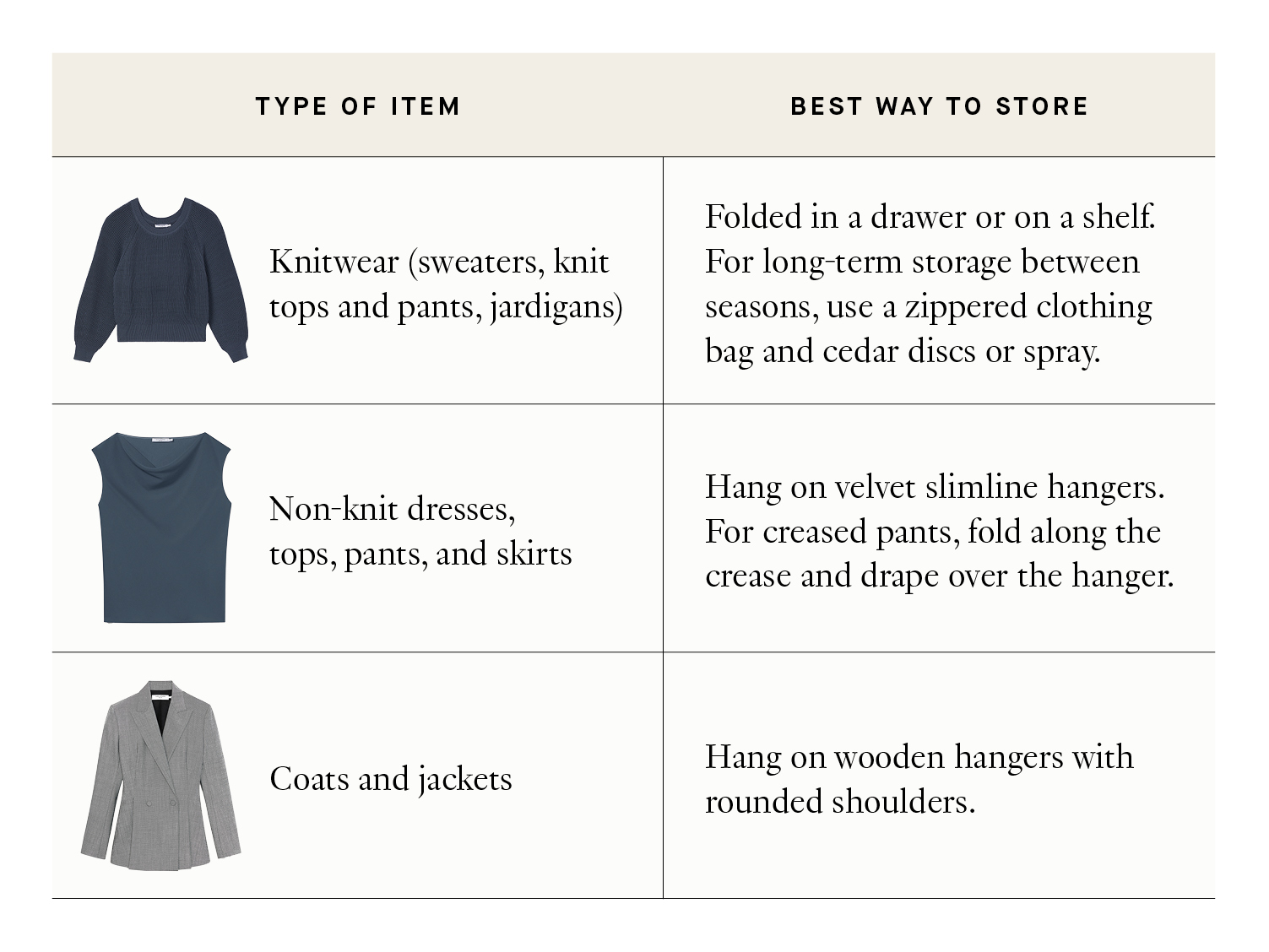
The Jo sweater and Milo jeans.
5 Sustainable Tweaks That Will Make Your Clothes Last Longer
Experts weigh in on the best ways to store, wash, and repair your clothes. (And yes, we included infographics.)
Want more M Dash?
Sign up for our weekly newsletter.
Thank you!
Sustainability in fashion is a tricky topic. The fashion industry is famous for being one of the world’s biggest sources of pollution, and although companies like M.M.LaFleur are taking major steps toward implementing responsible practices and investing in eco-conscious styles, it can be hard to balance the motivation to make sustainable choices with the desire to feel confident in the clothes you put on every day.
While it won’t solve everything, maximizing the longevity of your pieces is an incredibly important piece of the puzzle. So how do you make your clothes last as long as possible? The first step is to avoid fast fashion and invest in high-quality pieces that are designed to last—and if you shop at M.M., you’ve already got that part covered. From there, you just have to put in a little bit of care to keep your pieces going strong for years to come. To help, I asked our Senior Knitwear Designer (and the daughter of a professional dry cleaner/stain remover extraordinaire), Annie, and our Senior Product Development Manager, Shelby, about their best tips for storing, washing, and repairing your clothes.
1. Store Your Pieces Properly
If there’s one thing you remember about clothing storage, let it be this: You should always fold your knits—including sweaters, knit tops, and jardigans—rather than storing them on a hanger. Hanging these items will cause them to stretch and become misshapen over time. For longer-term storage (like storing your coats over the summer), wash or dry-clean your items, then store them in zipper bags, away from sunlight, with cedar discs to keep moths away. Alternatively, you can spray your items with The Laundress’s wool and cashmere spray, which contains cedar.
Any non-knit item is okay to hang, and for pieces like dresses, tops, and pants, Annie and Shelby recommend slimline velvet hangers to save storage space and prevent slippage. “For pants with a crease down the front, fold along the crease, then drape them over the hanger,” says Annie. For heavier items like blazers and coats, you should opt for wooden hangers with rounded shoulders to maintain the item’s shape. Annie recommends this convertible IKEA model that allows you to adjust the shape of the hanger depending on the garment.
What to do with those wire hangers from the dry cleaner? Annie says you should return them, which both helps out your local dry-cleaning business and prevents them from ending up in landfills. “Your dry cleaner will thank you, because they can reuse the hangers rather than buying more,” Annie explains. “Plus, storing your clothes on wire hangers long-term can put strain on the garment.”

The Jo sweater, Nora top, and Gaia jacket.
2. Follow the Care Instructions
Clothing companies like M.M.LaFleur do rigorous testing to determine which washing method will best maintain the look, feel, and longevity of each garment. And if a piece is labeled as machine-washable, it means not only that you can machine-wash it, but also that you should.
But let’s back up for a moment. Before you go to wash a garment, there are a few questions you should ask yourself: Is this actually dirty? Did I sweat in it? Spill on it? Does it smell? If you answered “no,” to those questions, it’s not time for the hamper. And if your piece is treated with Polygiene, an all-natural anti-odor finish, you can go even longer between washes. “Nothing should be washed after every wear, unless it’s very close to your skin, like undergarments or workout clothes,” says Annie. “Over-washing is not only very bad for the environment—it’s also very bad for your clothes.”
When it does come time to wash a piece, Shelby and Annie both recommend using cold water for everything but sheets and towels. “Hot water will set stains and shrink garments, and it’s generally more abrasive,” explains Annie. Plus, hot water uses significantly more energy.
3. Remove Stains Quickly
No matter the type of stain, there’s one rule that holds true across the board: The faster you act, the better. Check out our full guide to stain removal, then save this cheat sheet for quick reference:

4. Invest in Repairs
The most important thing to know about clothing repairs is that they’re a normal and inevitable part of owning something long-term. “There is a lot that can be done in terms of clothing repairs, but most people don’t explore them as much as they could,” says Annie. “It doesn’t matter how well-made a piece is or how much quality control went into it—eventually, everything will need a little spruce-up if you wear it for long enough. Luckily, if you find a good repair service, your previously damaged garment could feel like new when they’re done with it.”
Annie also notes that putting care into your clothing may help you gain a greater appreciation for where your pieces come from and, therefore, encourage thoughtful choices when you shop. “I think there’s something really nice about knowing that clothes aren’t perfect, machine-made things. With M.M. clothing, there’s always a human being who’s spent years honing their craft making your pieces. We have to take care of our clothes and not throw them away as soon as there’s an issue.” Plus, as Shelby mentions, repairing a piece is almost always cheaper than replacing it.
Ready to go get that hole patched but not sure where to go? Start with your local dry cleaner. Typically, they can either do the repair themselves or refer you to someone who can help.
5. Resell Unwanted Items
While in a perfect world, we’d wear all our pieces forever, the reality is that our bodies change, our wardrobe needs shift, and our personal style evolves. So, what’s the best way to get rid of unwanted clothing? We believe that reselling is the most responsible and rewarding route (did you know that when you resell a dress, you reduce its C02 impact by 79%?!). In fact, we even have our very own resale site, where you can buy and sell pre-loved M.M. items—because everyone deserves a second act, including your clothes. You can send non-M.M. items to our friends at thredUP, who will either resell or recycle them for you. Want to give back to your community? Donate workwear in good condition to our longtime partners at Bottomless Closet, so that your pieces can help more women thrive in their careers.










